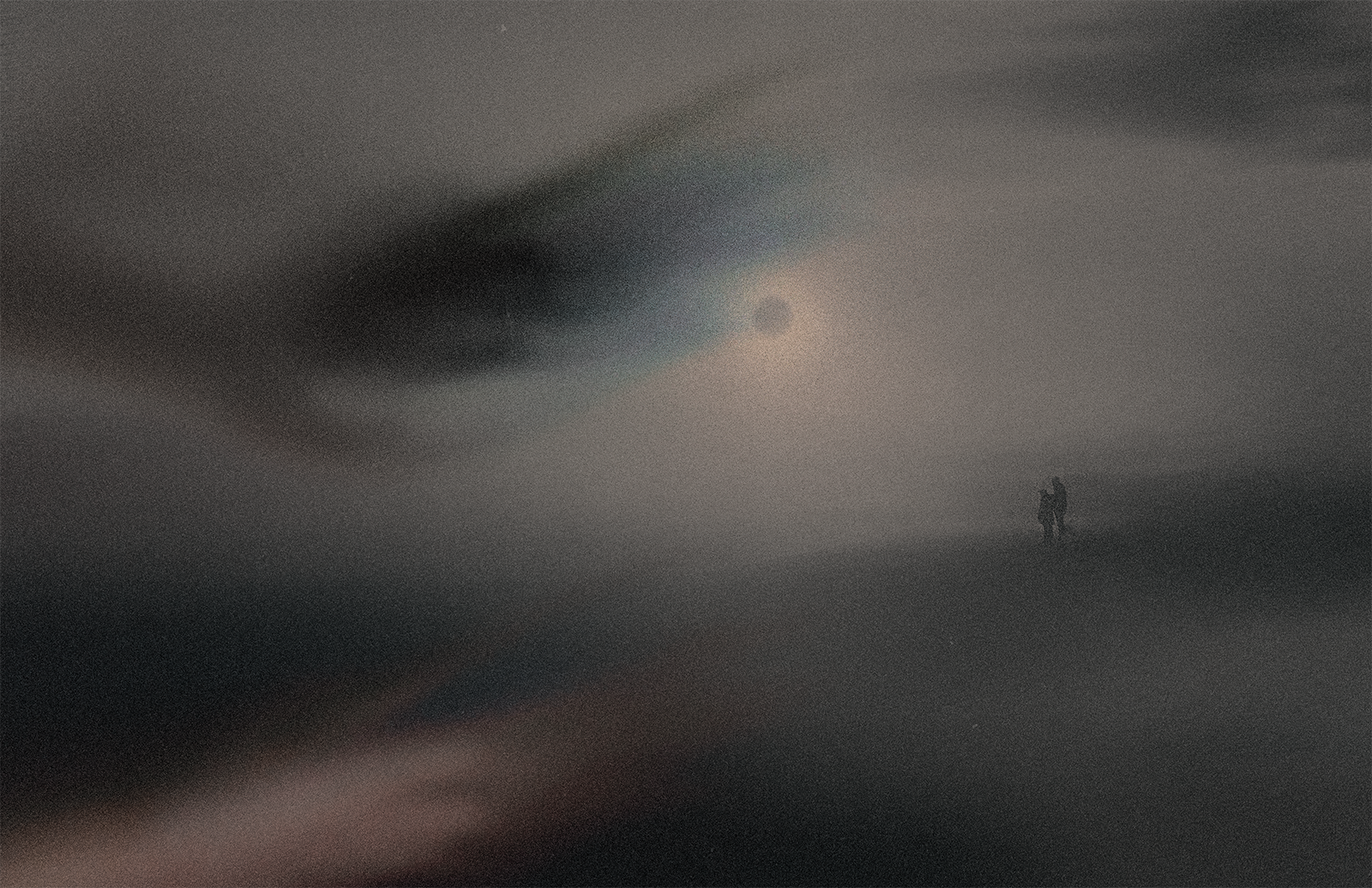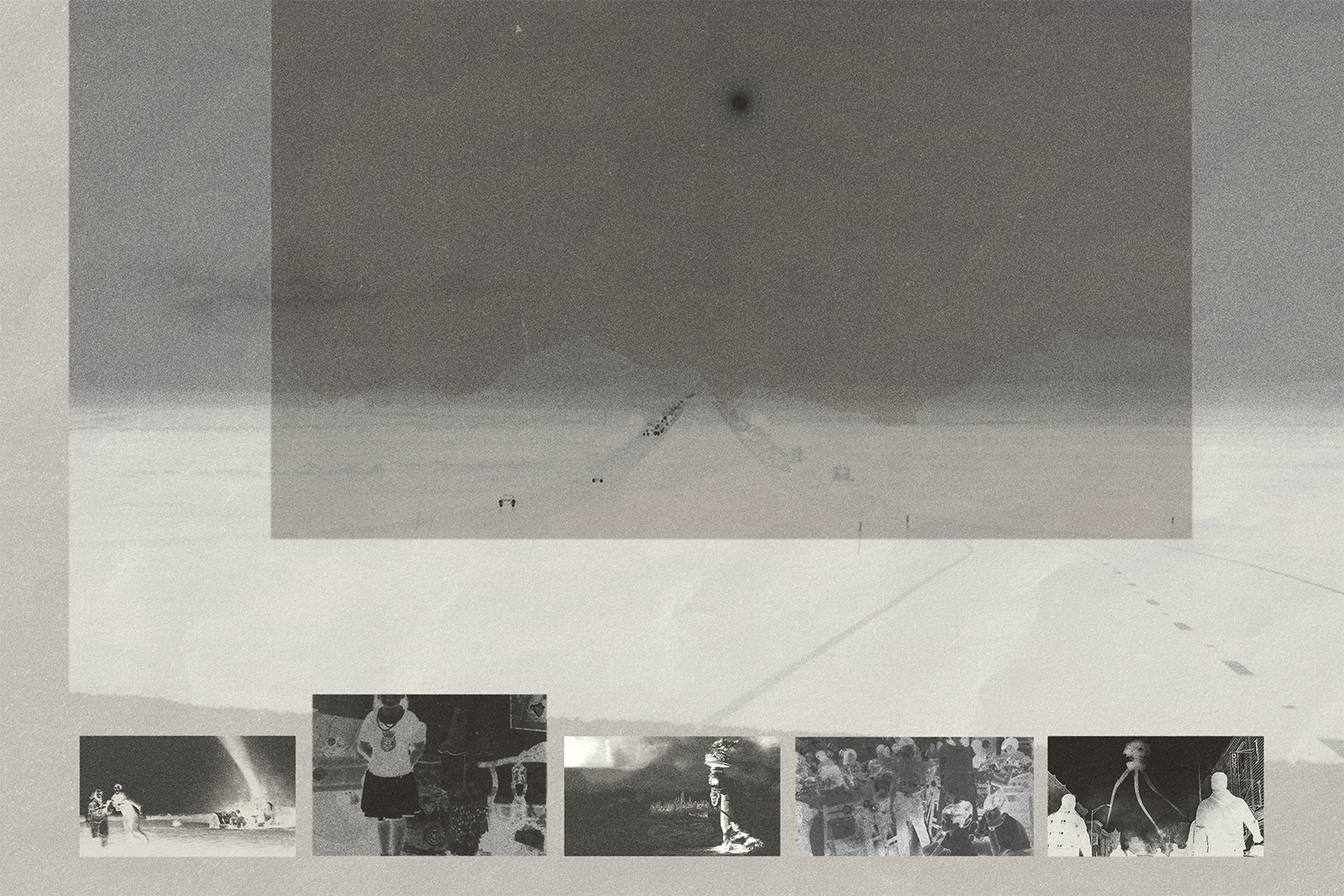A few months after we went to see the Barringer Crater and the Grand Canyon, D and I traveled to Santa Fe to find its shatter cones. I had read that they were sprinkled over a square mile in the Sangre de Cristo Mountains along Highway 475, and that the most accessible section could be found near a popular trailhead. Here we pulled over. We gazed out at the rock face, what we might drive by all the time without even thinking about it. Except for bicyclists flying by, the road was pretty much empty. I crossed it, climbing over a highway barrier to see the rock up close. And there they were, in easy plain view. The name was true. They looked like a series of conical trees in the rock. I touched the shatter cones and tried to comprehend, as I have tried so many times, the concept of time. A billion years ago, the Earth’s landmass was a supercontinent. Rodinia, it’s been named, precursor to the better-known Pangaea that formed some 500 million years later.
No, not everything that leaves, leaves a trace. Think of the metals that evaporated when the meteor hit that patch of land in northern Arizona, and how, thousands of years later, Daniel Barringer went searching for what he would never find. But think, also, of the weirdness of shatter cones, their shape and discovery. The years, the generations, that go into the making of a scientist who is able to understand how to read a sign in a rock, and decipher its long ago messages.
• • • •
So many things seem filled with the intent to be lost. I’ve been thinking about that line for thirty years now. It is a form of retrospective narration. Part deep depression, part deep acceptance.
The thing about love, about loving someone, is that, one way or another, there is always an ending.
• • • •
Nearly twenty years ago, before my first book, a memoir, was published, I sent the manuscript pages to my sister. I wasn’t asking for permission but in a way, I was. I was a little scared. That she would get mad at me, that she would contradict my perceptions of how we grew up. The same things every memoirist worries about. But she called me up and said, This could have been so much worse.
I thought she meant that the experience of reading the manuscript could have been worse, or that the book could have been worse-written. But it turned out that what she meant was that the stories themselves could have been worse. Harsher. Harder. Because, she said, that’s what she would have written down. My sister and I, two years apart, too often compared to each other, or rather against each other, hadn’t had the same childhood after all. All along I had thought her life easier—she was the prettier one, the one with more friends—yet she hadn’t felt that way at all.
Writing, maybe especially nonfiction writing, is a self-inflicted investigation of why we are even trying to do this in the first place. It’s trying to pin down a story, a feeling, a past, that can’t actually be pinned because we, the tellers and observers, are always changing. Nonfiction is a chase. It is the desire for confession and the necessity of restraint.
Sometimes, every bit of writing I do feels like an act of trespass. I say that because I really do not want to write about my sister, while knowing I can’t avoid it. It’s because I do not want this story to be true, and there’s no good resolution. I don’t want this to be the story of my sister’s life.
And there are so many things I can no longer ask her, because she can’t answer much beyond an inconsistent yes or no. It is unclear how much she can even see. Most likely, though I still cannot agree to believe this, she will never speak again.
In one of the last conversations I had with my sister, before the family reunion at Lake Michigan, we talked about aliens. I was visiting her and we were doing our usual thing, sitting at the kitchen counter, eating and gossiping and reminiscing. I asked if she remembered the time one of our uncles took us to see The Brother from Another Planet at Studio 28. It was hot, late summer, a matinee. My sister was eleven and I had just turned ten and we didn’t understand the movie; I remembered it as sometimes funny, sometimes sad, and deeply unsettling. My sister said she didn’t recall that, but she did remember going to that same theater to see Aliens, the one with Sigourney Weaver, and how we screamed at all the blood and violence. We then remembered Close Encounters of a Third Kind; E.T.; Independence Day. What’s with all the aliens? she said. And then we laughed, because of course, that’s exactly what my family had been trying to figure out by watching all these movies. Because we too, quite literally, were aliens. Our Resident Alien cards were proof of identity and status until we became citizens. It’s so weird that we grew up like that, my sister said. I knew what she meant. In less than a generation, we seemed light years away from what our dad and uncles and grandmother had gone through. And yet we were still refugees; it was still part of us. The alien within. My sister and I started talking about something else then, and we never went back to that subject though I wish we had. I keep wishing I could stay in that moment a little longer, or in that moment in the lake house when we drank champagne, or even those times when we were little girls saving the pieces of fruit our grandmother gave us. I swear my sister would agree if I said time feels more unreal as we get older. How thirty years ago can seem more real than three days ago.
In all the movies of my and my sister’s youth, the protagonists have to figure out what home is, and where they belong, and who they’re supposed to be. It’s always the same lesson, repeated, because no one ever really learns it.
All these years later, ongoing, I still think that if I can evidence and information my way to understanding, then I can mitigate the fear and actuality of disaster—even as it’s happening right in front of me. I have to remind myself that the concept of time is human-made, as are the names people give to stars, or to anything. I read that the earliest recordings of time are marked by women in the Stone Age, keeping track of menstruation. Is that actually true, or just true for now? The long past, like the long future, is part interpretation, part wonder. Here we are, always digging for more answers.
• • • •
When I brought my kids to the Grand Canyon, they were then eleven and thirteen years old. It was my first trip with just the three of us—a reimagined idea of family vacation, with me solely responsible. One day we were walking the rim trail when the sky suddenly shifted. A storm. We were about half a mile from the next trailhead that had a bus stop, and we could see lightning and rain heading toward us. It occurred to me that no one else knew where we were. Let’s hurry, I said, but I felt no panic. When we got to the trailhead, a bus appeared as if by summons. We boarded, and then the rain started. The bus driver announced that everyone out there needed to get picked up. We waited as people came bursting forth from the trail. Lightning and thunder closed in. The rain lashed at us. And I realized I was not scared; I was exhilarated. In the proceedings of divorce, maybe especially when children are involved, there are ample opportunities for guilt and grief. But then there are times, like on that bus, when you just know you’re going to be fine. And you are. And so we were.
My divorce had been finalized two months before, in a five-minute Zoom meeting while the kids were in school. Me, my ex, and the judge. She went through the settlement and custody agreement that we had signed. She asked each of us if we believed the marriage to be irretrievably broken. The question was expected but still startling in its directness. More direct than my ex-husband and I had been for most of our twenty-year marriage. I answered yes. My ex answered yes. And it was done. It’s wrong to say that I felt nothing. I don’t mean to say I felt nothing. But for me, the ending had been years in the making.
For some, divorce is a disaster, as when we describe someone as wanting to blow up their own life. For me, it was more like an unstoppable force—the more I contemplated it, the more certain it became. Like watching a river before it becomes part of a waterfall. Seeing a glass vase wobble, about to fall, and knowing it’s going to fall even before it happens. Once the ending begins, it has to continue. The impact of divorce might be a crater, a shatter cone, a buried structure. But we get to decide the shape, the visibility, the viability of such a fossil or scar.
It was April when I got divorced, and I was in my office in my house, which was now completely mine. I had paid to make it mine. I closed my computer and stood up. I went to my kitchen for a glass of water. Soon I would text D; later, that night, I would meet him at his hotel. But for another couple of hours, before my kids came home from school, I would be alone. In a way, aloneness is my most known, and thus most comforting, condition. It’s what I think of when I think of childhood, even with my sister. Probably this is what makes me a difficult person, too. But when I’m alone I am entirely unwitnessed, answerable to no one. And that, for good or ill, often feels like freedom.
One night in Santa Fe, D and I went out to observe the night skies. I am mediocre at identifying constellations and planets. I mean, I can do it, but I always lose my way. But everyone loves to look at stars because it approximates the feeling of magic. Even when we know that whatever we’re seeing is already dead, it’s kind of like viewing hundreds-year-old art in a museum. The painters and the people in their portraits are long gone, yet the work feels alive. Poets will always be writing about the stars and the moon, and so they should. Like love, how could we ever get enough? When we look into the sky we are trying to look into space, which is to say the future. The next meteors, asteroids. Whatever is coming, is already coming.



